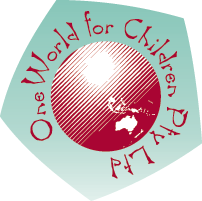Occupational Health and Safety Policy
 Policy
Policy
One World Children’s Centre will ensure all steps are taken to ensure the health, safety and wellbeing of employees, children, parents/guardians, students, volunteers, contractors and visitors, are provided with a safe and healthy environment
Legislation and Standard
Accident Compensation Act 1985, as amended 2007
AS/NZS 4804:2001 and 4801:2001 Occupational health and safety systems
Education and Care Services National Law Act 2010
Education and Care Services National Regulations 2011
National Quality Standard, Quality Area 2: Children’s Health and Safety
National Quality Standard, Quality Area 3: Physical Environment
National Quality Standard, Quality Area 7: Leadership and Service Management
Occupational Health and Safety Act 2004
Occupational Health and Safety Regulations 2007
Definitions:
The terms defined in this section relate specifically to this policy.
Duty of care: A common law concept that refers to the responsibilities of organisations to provide people with an adequate level of protection against harm and all reasonable foreseeable risk of injury. In the context of this policy, duty of care refers to the responsibility of education and care services to provide children, staff, students, volunteers, contractors and anyone visiting the service with an adequate level of care and protection against reasonable foreseeable harm and injury.
Hazard: An element with the potential to cause death, injury, illness or disease.
Hazard identification: A process that involves identifying all foreseeable hazards in the workplace and understanding the possible harm that each hazard may cause.
Hazard management: A structured process of hazard identification, risk assessment and control, aimed at providing safe and healthy conditions for employees, contractors and visitors while on the premises
Harm: Includes death, or injury, illness (physical or psychological) or disease that may be suffered by a person as a consequence of exposure to a hazard.
Material safety data sheet: Provides employees and emergency personnel with safety procedures for working with toxic or dangerous materials. The data sheet includes all relevant information about the material such as physical properties (e.g. melting/boiling point, toxicity and reactivity), health effects, first aid requirements and safe handling procedures (e.g. personal protective equipment, safe storage/disposal and management of spills).
Risk: The chance (likelihood) that a hazard will cause harm to individuals.
Risk assessment: A process for developing knowledge/understanding about hazards and risks so that sound decisions can be made about the control of hazards. Risk assessments assist in determining:
- what levels of harm can occur
- how harm can occur
- the likelihood that harm will occur.
Risk control: A measure, work process or system that eliminates an OHS hazard or risk, or if this is not possible, reduces the risk so far as is reasonably practicable.
Background
Everyone involved in an early childhood education and care service has a role to play in ensuring the service’s operations are safe and without risk to the health and safety of all parties. In Victoria, health and safety in the workplace is governed by a system of laws, regulations and compliance codes that set out the responsibilities of employers and employees to ensure safety is maintained at work.
The Occupational Health and Safety Act 2004 (OHS Act) sets out the key principles, duties and rights in relation to workplace health and safety. The Occupational Health and Safety Regulations 2007 specifies the ways duties imposed by the OHS Act must be undertaken and prescribes procedural/administrative matters to support the OHS Act, such as requiring licenses for specific activities, or the need to keep records or notify authorities on certain matters[1].
The legal duties of an employer under the OHS Act are:
- to provide and maintain a workplace that is safe and without risk to the health of employees. This responsibility extends to contractors for routine tasks over which the employer has management. For contractors completing non-routine tasks, the employer must ensure that the service’s daily operations and layout do not pose unreasonable risks
- to ensure other individuals, such as families and visitors, are not exposed to health and safety risks arising from the organisation’s activities
- to consult with employees about OHS matters that will, or will likely, affect employees directly, including identifying hazards and assessing risks, and making decisions about risk control measures.
The OHS Act places the responsibility on employees for:
- taking care of their own safety and the safety of others who may be affected by their actions
- co-operating with reasonable OHS actions taken by the employer, including following guidelines, attending OHS-related training, reporting incidents, co-operating with OHS investigations, encouraging good OHS practice with fellow employees and others at the service, and assisting the employer with conducting OHS inspections during operating hours
-
not interfering with safety equipment provided at the service, such as fire extinguishers.
Procedure
The Approved Provider (or delegate) is responsible for:
Providing and maintaining a work environment that is safe and without risks to health (OHS Act: Section 21). This includes ensuring that:
- there are safe systems of work
- all plant and equipment provided for use by staff, including machinery, appliances and tools etc., are safe and meet relevant safety standards
- substances, and plant and equipment, are used, handled, and stored safely
- material safety data sheets are supplied for all chemicals kept and/or used at the service (refer to www.ohsinecservices.org.au)
- there are adequate welfare facilities e.g. first aid and dining facilities etc.
- there is appropriate information, instruction, training and supervision for employees
(Note: This duty of care is owed to all employees, children, parents/guardians, volunteers, students, contractors and any members of the public who are at the workplace at any time)
- ensuring there is a systematic risk management approach (refer to www.ohsinecservices.org.au) to the management of workplace hazards.
This includes ensuring that:
- hazards and risks to health and safety are identified, assessed and eliminated or, if it is not possible to remove the hazard/risk completely, effectively controlled
- measures employed to eliminate/control hazards and risks to health and safety are monitored and evaluated regularly
Ensuring regular safety audits of the following:
- indoor and outdoor environments
- all equipment, including emergency equipment
- playgrounds and fixed equipment in outdoor environments
- cleaning services
- horticultural maintenance
- pest control
- monitoring the conditions of the workplace and the health of employees (OHS Act: Section 22)
- protecting other individuals from risks arising from the service’s activities, including holding an open day or a working bee etc., or any activity that is ancillary to the operation of the service e.g. contractors cleaning the premises after hours (OHS Act: Section 23)
- providing adequate instruction to staff in safe working procedures, and informing them of known hazards to their health and wellbeing that are associated with the work that they perform at the service
- ensuring that all plant, equipment and furniture are maintained in a safe condition
- developing procedures to guide the safe use of harmful substances, such as chemicals, in the workplace
- ensuring that OHS accountability is included in all position descriptions
- allocating adequate resources to implement this policy
- displaying this policy in a prominent location at the service premises
- ensuring the physical environment at the service is safe, secure and free from hazards for children
- implementing/practising emergency and evacuation procedures
- implementing and reviewing this policy in consultation with all staff
- identifying and providing appropriate resources, induction and training to assist educators, staff, contractors, visitors, volunteers and students to implement this policy
- ensuring the Nominated Supervisor, educators, staff, contractors, volunteers and students are kept informed of any relevant changes in legislation and practices in relation to this policy
Consulting appropriately with employees on OHS matters including:
- identification of hazards
- making decisions on how to manage and control health and safety risks
- making decisions on health and safety procedures
- proposed changes at the service that may impact on health and safety
- notifying WorkSafe Victoria about serious workplace incidents, and preserving the site of an incident (OHS Act: Sections 38–39)
- holding appropriate licenses, registrations and permits, where required by the OHS Act
- attempting to resolve OHS issues with employees or their representatives within a reasonable timeframe
- not discriminating against employees who are involved in health and safety negotiations
- allowing access to an authorised representative of a staff member who is acting within his/her powers under the OHS Act
- producing OHS documentation as required by inspectors and answering any questions that an inspector asks
- not obstructing, misleading or intimidating an inspector who is performing his/her duties.
The Occupational Health and Safety Officer is responsible for:
- ensuring that all educators/staff are aware of this policy, and are supported to implement it at the service
- ensuring that all equipment and materials used at the service meet relevant safety standards
- ensuring the service is up to date with current legislation on child restraints in vehicles if transporting children
- implementing and practising emergency and evacuation procedures
- implementing and reviewing this policy in consultation with the management team and all staff, contractors and parents/guardians
- identifying and providing appropriate resources and training to assist educators, staff, contractors, visitors, volunteers and students to implement this policy
- keeping up to date and complying with any relevant changes in legislation and practices in relation to this policy.
Certified Supervisors and other educators/staff are responsible for:
- taking care of their own safety and the safety of others who may be affected by their actions
- co-operating with reasonable OHS actions taken by the Approved Provider, including:
- following OHS rules and guidelines
- helping to ensure housekeeping is of the standard set out in service policies
- attending OHS training as required
- reporting OHS incidents
- co-operating with OHS investigations
- encouraging good OHS practices with fellow employees and others attending the service
- assisting the Approved Provider with tasks relating to OHS, such as conducting OHS inspections during working hours
- not interfering with safety equipment provided by the Approved Provider
- practising emergency and evacuation procedures
- ensuring the physical environment at the service is safe, secure and free from hazards for children
- maintaining a clean environment daily, and removing tripping/slipping hazards as soon as these become apparent
- ensuring the service is up to date with current legislation on child restraints in vehicles if transporting children
- implementing and reviewing this policy
- ensuring regular safety audits of the following: (Qualified staff are responsible in delegating staff to do these audits )
- indoor and outdoor environments
- all equipment
- playgrounds and fixed equipment in outdoor environments
- horticultural maintenance
- ensuring that all cupboards/rooms are labelled accordingly, including those that contain chemicals and first aid kits, and that child-proof locks are installed on doors and cupboards where contents may be harmful
- ensuring the physical environment at the service is safe, secure and free from hazards for children
Students on placements, volunteers, contractors and parents/guardians at the service are responsible for:
- being familiar with this policy
- co-operating with reasonable OHS rules implemented by the service
- not acting recklessly and/or placing the health and safety of other adults or children at the service at risk.
Sourses
Early Childhood Management Manual, KPV
Getting into the Act, WorkSafe Victoria
Getting help to improve health and safety, WorkSafe Victoria
Guide to the OHS Act 2004, WorkSafe Victoria
Managing safety in your workplace, WorkSafe Victoria
OHS in Early Childhood Services (KPV): www.ohsinecservices.org.au
WorkSafe Victoria: www.worksafe.vic.gov.au





 One World for Children Acknowledgement of Country: Here is the land; Here is the sky; Here are my people and here am I. We give thanks to future, present and past; Ancestors and Elders and the connection that lasts. We acknowledge the Wathaurong people on whose land we learn and play; We promise to look after it every day. ©
One World for Children Acknowledgement of Country: Here is the land; Here is the sky; Here are my people and here am I. We give thanks to future, present and past; Ancestors and Elders and the connection that lasts. We acknowledge the Wathaurong people on whose land we learn and play; We promise to look after it every day. ©